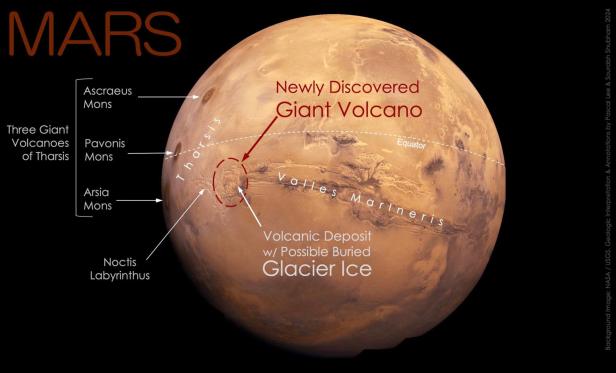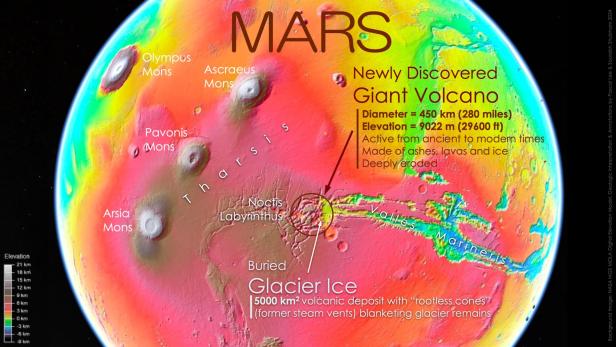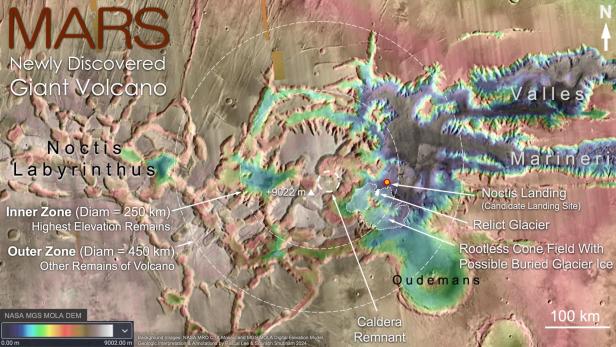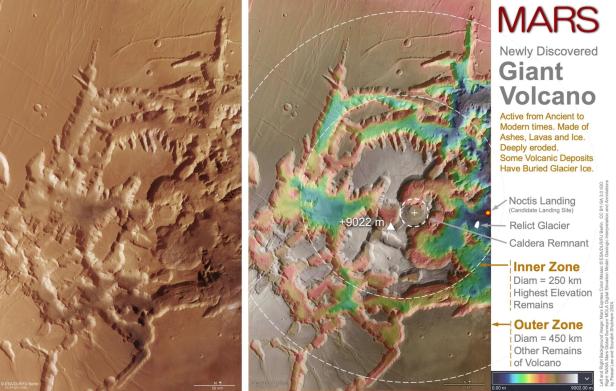© NASA/ESA, J. Bell (Cornell University) and M. Wolf (SSI)
“Hidden in plain sight”: This saying applies to the new discovery Mars to. Researchers have found a volcano so massive they never realized it was a volcano.
“We were just surveying the topography of the area where we found the remains of a glacier last year,” he says. “That’s when we realized we were in a huge, eroded volcano.” Pascal Lee, lead author of the study and a planetary scientist at NASA's Mars Institute. Naturally, he and his team were not there: the images and data were used in the discovery 7 Mars orbits It has been studied, starting with Mariner 9, which orbited the planet in 1972, according to reports Phys.org.
Mars
© City Institute
Bigger than Ireland, higher than Mount Everest
The diameter of the volcano is 450 km. This means that the entire island of Ireland will fit into it. He is with 9,022 metres Higher than Mount Everest.
It is located on the border between two prominent regions on Mars. One is that Noctis Maze (Night Maze) was given this name because of its many fractures. The other area is Valles Marineres (Mariner Valleys), a rift valley system with impressive canyons.
The volcano does not yet have an official name. Due to its geographical location on Mars, it is currently temporary Noctis volcano Named. Its size and degree of erosion indicate that it has been active for a long time.
Mars
© City Institute
Several clues
The fact that the volcano was finally recognized as such is due to several pieces of evidence. In the center she is PlateausWhich forms an arc. They are steeper inward and flatter outward.
Near the center is a single remains Collapsed volcanic craterWhich was filled with a lava lake. Channelscreated by volcanic lava, Deposits of ash and slag as well as storage Hydrogenated metals (minerals whose crystal structure is formed by their reaction with water) can also be found.
“This region of Mars is known to contain a wide range of hydrated minerals. It has long been suspected that these minerals have a volcanic origin. So it is not surprising that we find a volcano here,” he says. Saurabh Shubhamone of the study's authors.
Mars
© City Institute
Bubbles and jarosite
In the volcano area, an area of 5,000 square kilometers containing volcanic deposits was discovered. These look like flat, rounded hills and are called “Bubble like“It was likely formed because a hot layer of volcanic material covered water or ice. The heat created water vapor underneath, causing the cooling layer above to swell.”
Last year, the remains of an ancient volcano were discovered Glacier is found. There was evidence of this from the deposit Jarocite. This was probably caused by a chemical reaction between the mantle of volcanic material and the glacial ice.
➤ Read more: NASA says goodbye: The final flight of the Mars Ingenuity helicopter
Eventful past
Noctis Volcano appears to have had an eventful geological history. The corrosion is likely gone Fractures, heat and glaciers Originated. Fractures and fissures occurred due to pressure on the many layers of volcanic sediments, hardened lava, snow and ice. In these fractures, lava was able to advance to different locations on the volcano, resulting in heat-induced erosion. Large amounts of trapped ice also melted. The result was sediment voids, which eventually led to the collapse of entire sections of the volcano.
Little by little, more glaciers disappeared, leaving prominent rivers the canyons Back at the volcano, which is still visible today. The icy remains found in the area last year may be the latest traces of this erosion caused by glaciers.
Mars
© City Institute
Noctis Volcano still holds mysteries
While these theories seem fairly conclusive, the supervolcano still holds some secrets. For example, it is not clear when in Mars' history a volcano actually became active, and whether it ever happened Still active It is and could erupt again.
What's also exciting for future research is whether combining heat from volcanic activity with water from ice is possible life On Mars, long after the rest of the planet was already hostile to life.
➤ Read more: This is the number of people needed to establish a colony on Mars
If there is still glacial ice in this area beneath the volcanic sediments, this may be due to… Future Mars missions Uses. People could use this to extract water to produce oxygen for a Mars base and hydrogen for electricity or fuel.

“Social media evangelist. Baconaholic. Devoted reader. Twitter scholar. Avid coffee trailblazer.”











More Stories
These brands are most vulnerable to phishing scams
Apple Maps Now Has a Web Version and Wants to Challenge Google Maps
Best AirDrop Alternatives for Android